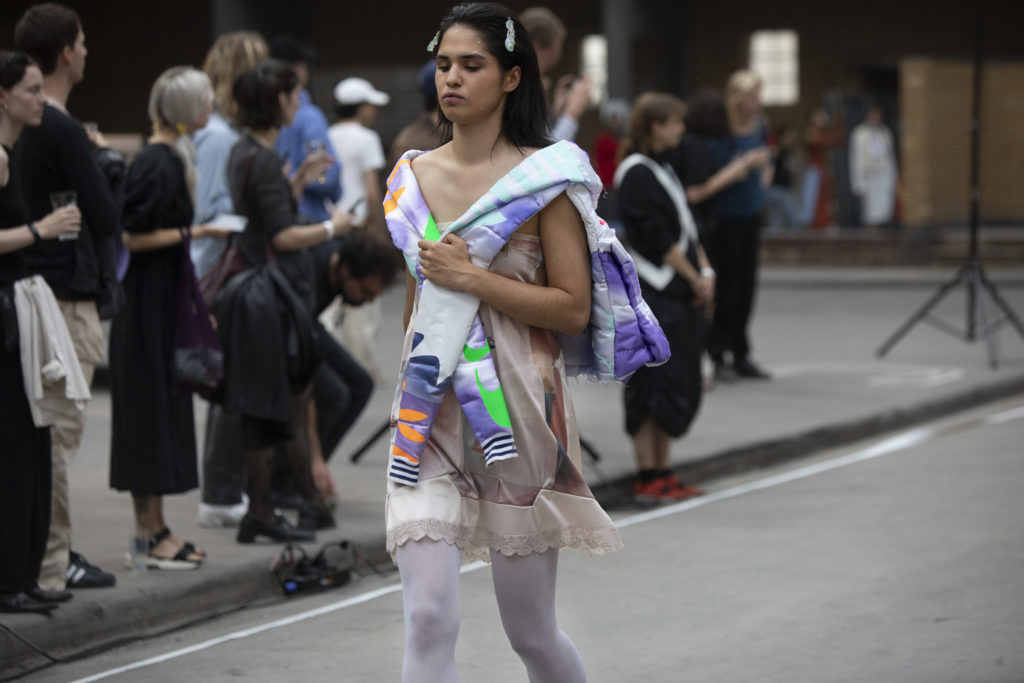We are more than proud to present the 10 finalists of Lichting 2022. Before their debut to the public on the 2nd of September, AFW sat down with each participant to talk about their collection and their plans for the upcoming Lichting show. This week we would like to introduce you to Gerrit Rietveld Academy graduate Enzo Aït Kaci De Tandt!
How did the concept behind your graduation collection come to being?
I had a clear vision of my graduation process being a complex excel file with algorithm and action-reaction arrows that absorbs every single information that passes through it. Influenced by the way information circulates on internet, I have been fascinated with the idea of clothes becoming images and existing in both physical and digital realities. During my collaboration with photographer Simon Pillaud and illustrator Hyoyoung Chu on developing a visual garment, I realised I didn’t have the desire to make my work ending up digital. I wanted digital matters to grow influence on the development of physical pieces. For my graduation project ‘360°’ I decided to reuse the digital pieces I created during my bachelor to generate a new core of physical work. I got very obsessed with outlining all my previous photography work to develop textile prints. My early intentions were to copy-paste my own work and see how it could lead to new outcomes.
How would you describe your signature as a designer? How does this reflect in your collection?
Prior to my fashion study, I studied graphic design and digital communication. I carried that background alongside my practice of fashion. My position was clear since the beginning: I wanted to produce image from garment making and see how those images can produce garments as well. Therefore, I believe my sensitivity for image-making is very transparent in my work. On the other hand, I find it hard to identify as a designer. I see myself as a researcher fundamentally. It encompasses literature research, music, film, anime, video-clips, photography books, video-games and any form of visual matters. I would define the core of my practice as such: a strong interest for visual cultures and solid theoretical references. For instance, I wrote my thesis about my grandmother and her fictive discovery of the internet code. I made a lot of visual collages and highjacked random internet images to create a visual story. For the graduation catwalk I also highjacked the models of my classmates. All those approaches reflect on my practice and reveal my interest to reuse what already exist in a specific context. That context can be internet, my classmates’ models, my own work.

On July 29th, you were introduced to the Lichting jury for the first time. How did you experience this moment? What feedback do you take with you to your presentation during AFW?
I was very excited to meet the jury. A few seconds before I left the room, one of the jury members asked me what narrative the print I developed carries? I shortly explained it. I then realised that I have this fantasy of explaining the project with some glamour. What I mean by that is to manage to pitch your project with a certain balance of what to reveal and what to keep for yourself. I’m quite nerdy when it comes to explanation and I like to dismantle every aspect of the project in-depth. I asked myself if it’s worth to overpitch it or to pitch it too briefly. Sometimes I get bored when someone explains every single aspect of their intentions. I would like to find the right information myself in that case. Maybe I already overexplained myself in this question (laugh).
Which piece from the collection are you most proud of? Why?
One part of the project was a series of prints that I framed as textile pieces and didn’t turn into garments. I liked that one a lot. Still one of my favourite pieces is the black bag. It is made of polyester satin fabric and thick padding. The prints are made of white vinyl and are outlined of photography of a previous bag I made with the same shape. I find that poetic and absurd, that clothes have a print with its own photography documentation. I like that looping very much.

What would be the ideal way to present your collection to the public in September? Can you already say something about what you currently have in mind?
In the past months my collection has been presented through an installation and a catwalk. At the moment, I am very interested in rethinking the catwalk as an experimental stage. One further step in my project was not to only highjack my own work but to highjack my surroundings and see how digital works can spread into a physical reality.
